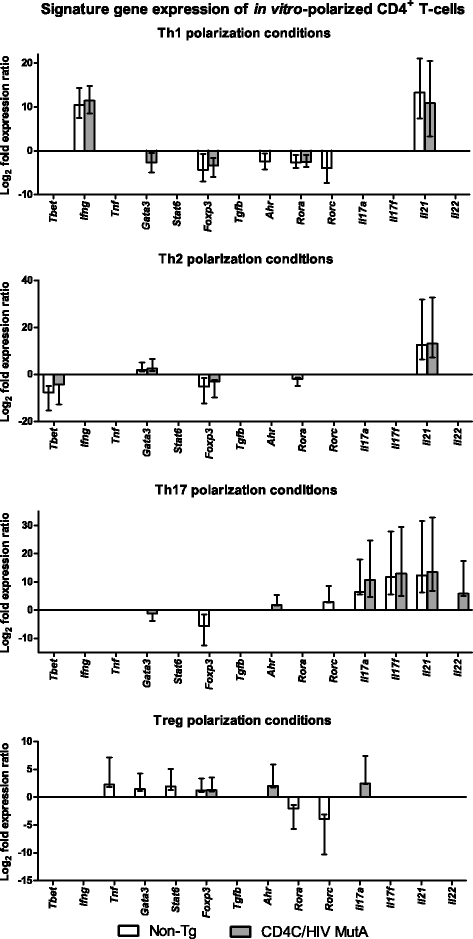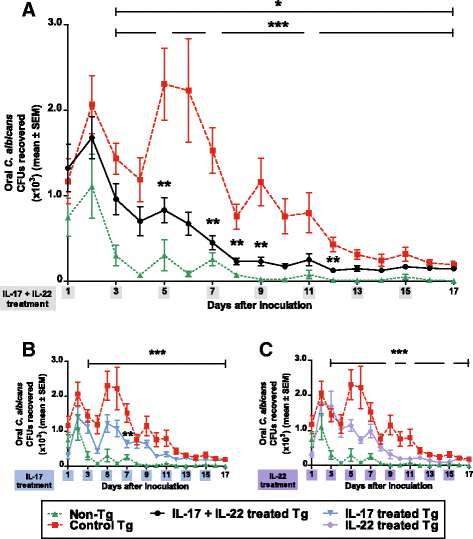Defective IL-17- and IL-22-dependent mucosal host response to Candida albicans determines susceptibility to oral candidiasis in mice expressing the HIV-1 transgene
- PMID: 25344377
- PMCID: PMC4213580
- DOI: 10.1186/s12865-014-0049-9
Defective IL-17- and IL-22-dependent mucosal host response to Candida albicans determines susceptibility to oral candidiasis in mice expressing the HIV-1 transgene
Abstract
Background: The tissue-signaling cytokines IL-17 and IL-22 are critical to host defense against oral Candida albicans infection, by their induction of oral antimicrobial peptide expression and recruitment of neutrophils. Mucosal Th17 cells which produce these cytokines are preferentially depleted in HIV-infected patients. Here, we tested the hypothesis that defective IL-17- and IL-22-dependent host responses to C. albicans determine the phenotype of susceptibility to oropharyngeal candidiasis (OPC) in transgenic (Tg) mice expressing HIV-1.
Results: Naïve CD4+ T-cells and the differentiated Th1, Th2, Th17, Th1Th17 and Treg lineages were all profoundly depleted in cervical lymph nodes (CLNs) of these Tg mice. However, naive CD4+ cells from Tg mice maintained the capacity to differentiate into these lineages in response to polarizing cytokines in vitro. Expression of Il17, Il22, S100a8 and Ccl20 was enhanced in oral mucosal tissue of non-Tg, but not of Tg mice, after oral infection with C. albicans. Treatment of infected Tg mice with the combination of IL-17 and IL-22, but not IL-17 or Il-22 alone, significantly reduced oral burdens of C. albicans and abundance of Candida hyphae in the epithelium of tongues of infected Tg mice, and restored the ability of the Tg mice to up-regulate expression of S100a8 and Ccl20 in response to C. albicans infection.
Conclusions: These findings demonstrate that defective IL-17- and IL-22-dependent induction of innate mucosal immunity to C. albicans is central to the phenotype of susceptibility to OPC in these HIV transgenic mice.
Figures






Similar articles
-
Altered CD4+ T cell phenotype and function determine the susceptibility to mucosal candidiasis in transgenic mice expressing HIV-1.J Immunol. 2006 Jul 1;177(1):479-91. doi: 10.4049/jimmunol.177.1.479. J Immunol. 2006. PMID: 16785545
-
CD8+ T cells but not polymorphonuclear leukocytes are required to limit chronic oral carriage of Candida albicans in transgenic mice expressing human immunodeficiency virus type 1.Infect Immun. 2006 Apr;74(4):2382-91. doi: 10.1128/IAI.74.4.2382-2391.2006. Infect Immun. 2006. PMID: 16552068 Free PMC article.
-
Th17 cells and IL-17 receptor signaling are essential for mucosal host defense against oral candidiasis.J Exp Med. 2009 Feb 16;206(2):299-311. doi: 10.1084/jem.20081463. Epub 2009 Feb 9. J Exp Med. 2009. PMID: 19204111 Free PMC article.
-
Immunity to Candida.Oral Dis. 2002;8 Suppl 2:69-75. doi: 10.1034/j.1601-0825.2002.00015.x. Oral Dis. 2002. PMID: 12164664 Review.
-
Candida-host interactions in HIV disease: relationships in oropharyngeal candidiasis.Adv Dent Res. 2006 Apr 1;19(1):80-4. doi: 10.1177/154407370601900116. Adv Dent Res. 2006. PMID: 16672555 Review.
Cited by
-
Sequential Dysfunction and Progressive Depletion of Candida albicans-Specific CD4 T Cell Response in HIV-1 Infection.PLoS Pathog. 2016 Jun 9;12(6):e1005663. doi: 10.1371/journal.ppat.1005663. eCollection 2016 Jun. PLoS Pathog. 2016. PMID: 27280548 Free PMC article.
-
Nystatin enhances the immune response against Candida albicans and protects the ultrastructure of the vaginal epithelium in a rat model of vulvovaginal candidiasis.BMC Microbiol. 2018 Oct 25;18(1):166. doi: 10.1186/s12866-018-1316-3. BMC Microbiol. 2018. PMID: 30359236 Free PMC article.
-
The IDO-AhR Axis Controls Th17/Treg Immunity in a Pulmonary Model of Fungal Infection.Front Immunol. 2017 Jul 24;8:880. doi: 10.3389/fimmu.2017.00880. eCollection 2017. Front Immunol. 2017. PMID: 28791025 Free PMC article.
-
Regulation of host-microbe interactions at oral mucosal barriers by type 17 immunity.Sci Immunol. 2020 Jan 3;5(43):eaau4594. doi: 10.1126/sciimmunol.aau4594. Sci Immunol. 2020. PMID: 31901072 Free PMC article. Review.
-
Oral epithelial IL-22/STAT3 signaling licenses IL-17-mediated immunity to oral mucosal candidiasis.Sci Immunol. 2020 Jun 5;5(48):eaba0570. doi: 10.1126/sciimmunol.aba0570. Sci Immunol. 2020. PMID: 32503875 Free PMC article.
References
-
- Martins MD, Lozano-Chiu M, Rex JH. Declining rates of oropharyngeal candidiasis and carriage of Candida albicans associated with trends toward reduced rates of carriage of fluconazole-resistant C. albicans in human immunodeficiency virus-infected patients. Clin Infect Dis. 1998;27(5):1291–1294. doi: 10.1086/515006. - DOI - PubMed
-
- Fabian FM, Kahabuka FK, Petersen PE, Shubi FM, Jurgensen N. Oral manifestations among people living with HIV/AIDS in Tanzania. Int Dent J. 2009;59(4):187–191. - PubMed
Publication types
MeSH terms
Substances
Grants and funding
LinkOut - more resources
Full Text Sources
Other Literature Sources
Medical
Molecular Biology Databases
Research Materials
Miscellaneous

